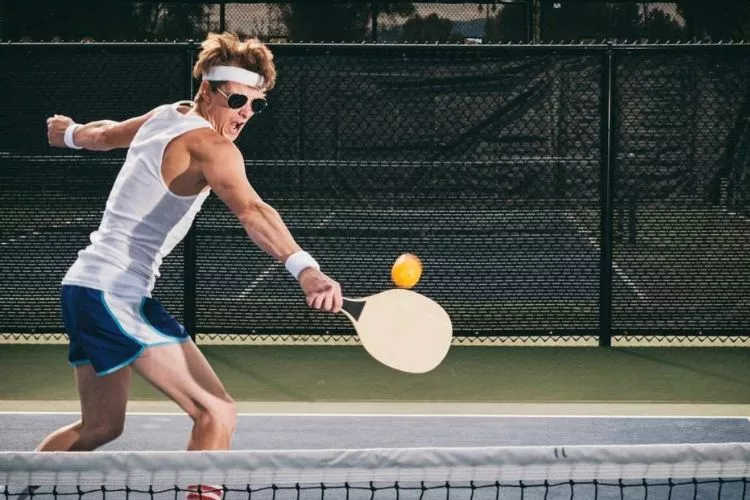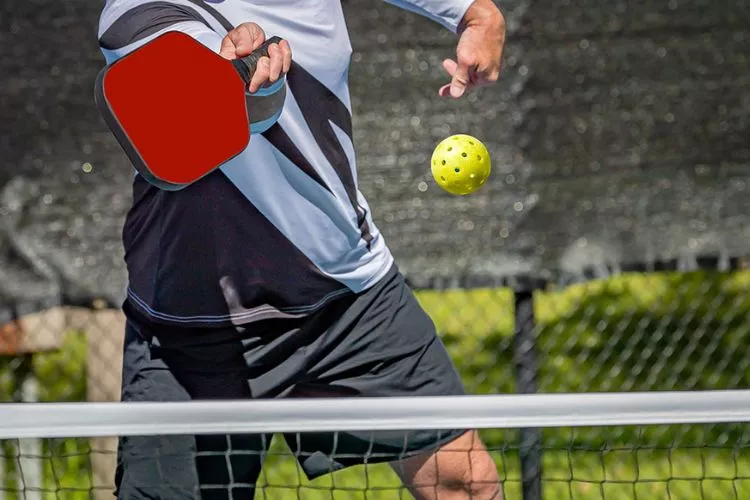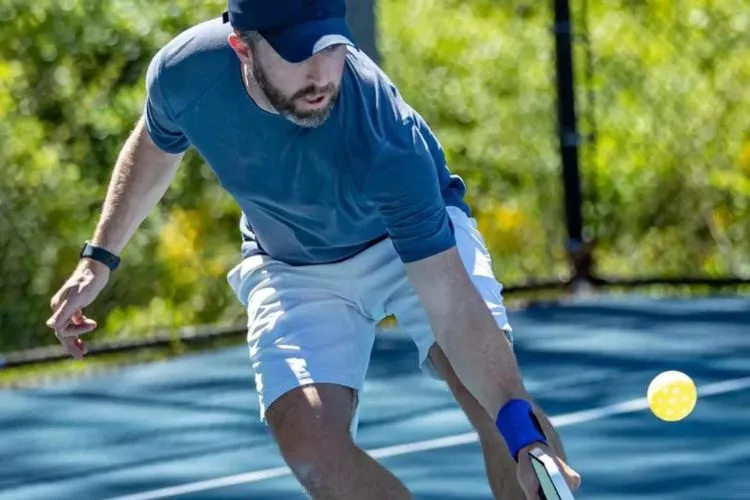When it comes to playing pickleball, understanding and incorporating different shot techniques can greatly enhance your gameplay.
One such technique that can be a game-changer is the chop shot.
But, what exactly is a Chop in pickleball?
Also known as the slice or backspin, a chop is a shot that creates backspin on the ball, giving it a unique trajectory and added control.

In this comprehensive guide, we will delve into the world of pickleball chops, exploring the techniques, strategies, benefits, and more.
Techniques of Executing a Pickleball Chop
To execute a successful chop shot, it is essential to master the proper technique. Here are the key aspects to focus on:
- Proper Grip and Stance: The first step in executing a pickleball chop is positioning your grip and stance correctly. Hold the paddle with a continental grip, which allows for versatility in shot selection. Stand in a neutral position, with your knees slightly bent and your weight evenly distributed.
- Body Positioning for a Chop Shot: Positioning your body correctly is crucial for generating power and control. Rotate your shoulders and hips as you prepare to hit the shot, ensuring that you are facing the net. Keep your non-dominant hand pointing towards the target to aid in balance and stability.
- Swing Mechanics and Racquet Angle: The swing mechanics for a chop shot involve a downward motion with a closed racquet face. As you swing, aim to brush the paddle against the back of the ball, generating backspin. Focus on making clean contact with the ball, using your wrist to add further spin.
- Generating Backspin: To achieve a successful chop shot, it is essential to generate sufficient backspin. This can be achieved by brushing the paddle against the back of the ball and imparting a downward force. The more leverage you apply, the more backspin you can produce.
What is a Chop in Pickleball? Different Variations of Pickleball Chops
Chop shots can be executed from various positions on the court. Here are the different variations of pickleball chops:

Forehand Chop Technique: The forehand chop is executed by swinging the paddle in a downward motion across the body. Use your wrist to generate backspin while maintaining control and accuracy.
This shot is particularly effective when countering powerful shots from your opponent, allowing you to create a low trajectory and increase the chance of the ball falling within the opponent’s non-volley zone.
Backhand Chop Technique: Similar to the forehand chop, the backhand chop involves a downward swing motion but executed on the opposite side of the body.
With the correct positioning and wrist action, the backhand chop can be a valuable defensive tool against powerful shots directed towards your backhand side.
Overhead Chop Technique: The overhead chop is employed when the ball is above your shoulder level, requiring a different angle of attack. Using an overhead backhand grip, swing the paddle in a downward motion, making contact with the ball from above.
This shot is often used to counter high lobs or to intentionally create a low trajectory, making it difficult for your opponent to return.
Strategies for Incorporating Chops into Gameplay
Now that we have covered the techniques for executing a chop shot, let’s explore how to strategically incorporate them into your gameplay:
Defensive Use of Chops to Disrupt Opponents: One of the main advantages of a chop shot in pickleball is its ability to disrupt your opponent’s rhythm.
By introducing backspin, the ball will have a different trajectory from the usual shots, causing difficulties for your opponent to anticipate or return it effectively. Use chop shots strategically to throw off your opponent’s timing and control the pace of the game.
Offensive Use of Chops for Surprise Shots: Chop shots can also be employed offensively to catch your opponent off-guard.
By incorporating chops into your shot selection, you can create unpredictable shots that your opponent may struggle to handle. These surprise shots can help you gain a competitive edge and keep your opponent guessing.
Using Chops to Control the Pace of the Game: In addition to throwing off your opponent’s rhythm, chops provide you with the ability to control the pace of the game.
Slow the game down by introducing well-placed chop shots, giving yourself more time to recover and plan your next move. Alternating between faster shots and chop shots can disrupt your opponent’s game plan and force them to adjust their strategy.
Benefits and Advantages of Pickleball Chops
Incorporating pickleball chops into your gameplay can offer several benefits and advantages:

Creating Unpredictable Shots for Opponents: By adding backspin to your shots, you create a unique trajectory that is challenging for opponents to read and anticipate.
This unpredictability can lead to errors from your opponents and open up opportunities for winners.
Increasing Shot Placement Accuracy: Chop shots allow for greater control and shot placement accuracy. The backspin reduces the ball’s forward momentum, making it easier to keep the shot within certain areas of the court.
This precision enables you to strategically place shots in areas that can create difficulties for your opponent.
Enhancing Shot Selection Versatility: Mastering chops expands your shot selection arsenal, providing you with a wider range of options during gameplay.
Instead of relying solely on power shots or dinks, incorporating chops gives you more versatility in shot selection, allowing you to adapt to various game situations.
Pro Tips for Mastering Pickleball Chops
Here are some pro tips to help you master the art of pickleball chops:
- Practicing Proper Footwork and Positioning: Footwork plays a crucial role in executing effective chop shots. Practice moving your feet quickly and maintaining a balanced stance to ensure you are in the optimal position to execute the shot.
- Applying the Right Amount of Power and Control: Finding the balance between power and control is essential for successful chop shots. Experiment with different levels of power and focus on maintaining control when executing the shot. Practice generating backspin consistently without sacrificing accuracy.
- Developing Consistency Through Drills and Match Play: Consistency is key when it comes to mastering chop shots. Incorporate specific drills that focus on developing the technique and generating backspin. Additionally, seek opportunities to apply chop shots during match play to gain confidence and refine your skills.
Common Mistakes to Avoid when Executing Pickleball Chops
Avoid these common mistakes to ensure your chop shots are effective and reliable:

- Improper Racquet Angle and Swing Technique: One of the most common mistakes is improper racquet angle and swing technique. Aim to maintain a closed racquet face and a downward swing motion to produce the desired backspin. Consistently practicing the correct technique will lead to more consistent chop shots.
- Inconsistency in Generating Backspin: Inconsistent backspin can significantly impact the effectiveness of a chop shot. Focus on brushing the paddle against the back of the ball in a consistent manner to generate reliable backspin. Practice generating backspin consistently to ensure your shots have the intended effect.
- Overusing Chops and Neglecting Other Shot Options: While pickleball chops are a valuable tool in your arsenal, it’s important not to overuse them. Over-reliance on chops can make your game predictable and allow your opponent to adjust their strategy accordingly. Maintain a balanced shot selection, incorporating other shots to keep your opponent guessing.
Frequently Asked Questions (FAQs)
What is the difference between a chop and a slice in pickleball?
In pickleball, the terms u0022chopu0022 and u0022sliceu0022 are used interchangeably to describe a shot that imparts backspin on the ball. The key difference lies in the naming convention, with some players preferring one term over the other.
Can you use a chop shot from any position on the court?
Yes, chop shots can be executed from various positions on the court. However, they are particularly effective when countering powerful shots or creating unpredictable shots to disrupt your opponent’s rhythm.
How do I counter a chop shot from my opponent?
When facing a chop shot from your opponent, be prepared for the ball to have a lower trajectory and possibly more spin. Anticipate the ball’s bounce to adjust your footwork and positioning accordingly. Practice returning chop shots to develop familiarity and efficiency in countering them.
Are there any specific drills to improve chop shots?
Yes, there are several drills that can help improve your chop shots. One effective drill is the u0022Chop and Lobu0022 drill, which involves alternating between chop shots and lobs to practice control and shot selection. Another drill is the u0022Chop and Dinku0022 drill, where you alternate between chops and dinks to develop tactical awareness and shot variety.
Conclusion:
Mastering pickleball chops can elevate your gameplay by introducing unique shots that surprise and challenge your opponents.
By understanding the proper techniques, exploring different variations, and strategically incorporating chops into your gameplay, you can gain an advantage on the pickleball court.
With consistent practice and an understanding of the benefits and advantages, enhancing your shot selection with chops can take your pickleball skills to new heights.
So, get out on the court, practice your chops, and embrace the thrill of this versatile shot technique.

Pickleball’s more than a game to me—it’s a passion. I write, sharing its highs and lows, the thrills and the lessons. Some tales might draw you to the court, while others give a hint of the game’s magic. So, curious about my journey? Ready to dive deep into the world of pickleball with me? Let’s go.
